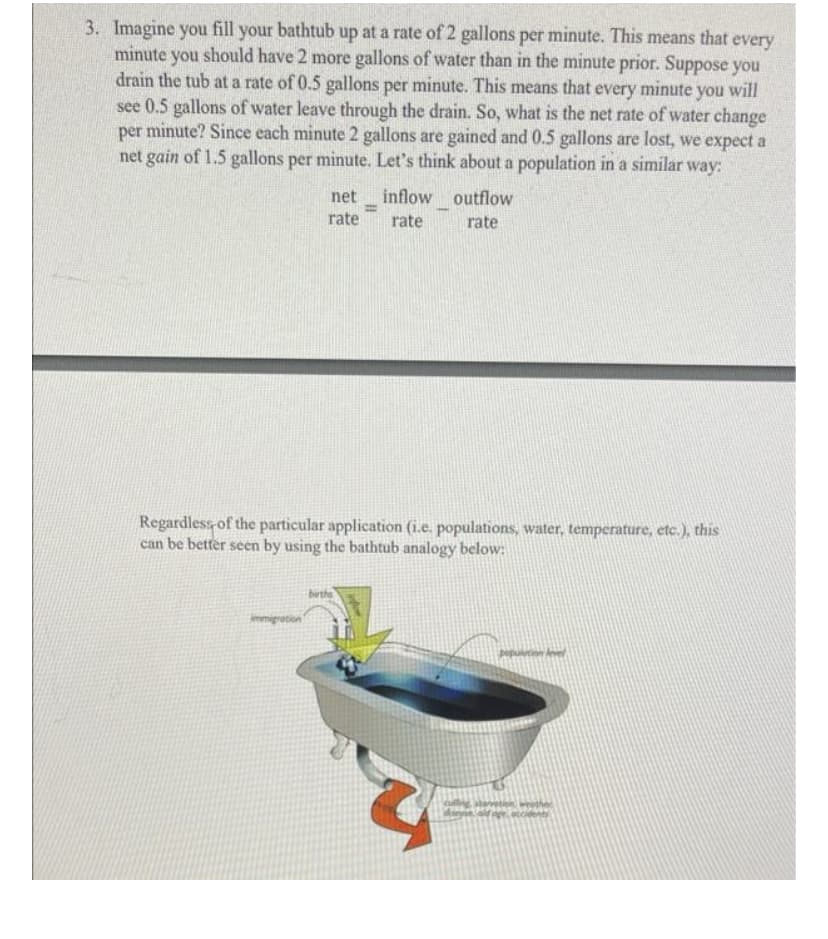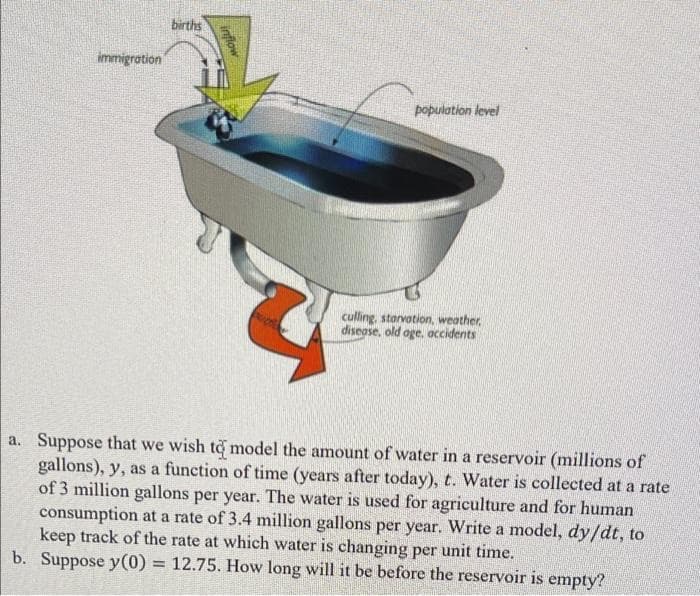3. Imagine you fill your bathtub up at a rate of 2 gallons per minute. This means that every minute you should have 2 more gallons of water than in the minute prior. Suppose you drain the tub at a rate of 0.5 gallons per minute. This means that every minute you will see 0.5 gallons of water leave through the drain. So, what is the net rate of water change per minute? Since each minute 2 gallons are gained and 0.5 gallons are lost, we expect a net gain of 1.5 gallons per minute. Let's think about a population in a similar way: inflow outflow net rate rate rate Regardless of the particular application (i.e. populations, water, temperature, etc.), this can be better seen by using the bathtub analogy below: populucion A d
3. Imagine you fill your bathtub up at a rate of 2 gallons per minute. This means that every minute you should have 2 more gallons of water than in the minute prior. Suppose you drain the tub at a rate of 0.5 gallons per minute. This means that every minute you will see 0.5 gallons of water leave through the drain. So, what is the net rate of water change per minute? Since each minute 2 gallons are gained and 0.5 gallons are lost, we expect a net gain of 1.5 gallons per minute. Let's think about a population in a similar way: inflow outflow net rate rate rate Regardless of the particular application (i.e. populations, water, temperature, etc.), this can be better seen by using the bathtub analogy below: populucion A d
Algebra for College Students
10th Edition
ISBN:9781285195780
Author:Jerome E. Kaufmann, Karen L. Schwitters
Publisher:Jerome E. Kaufmann, Karen L. Schwitters
Chapter10: Exponential And Logarithmic Functions
Section10.2: Applications Of Exponential Functions
Problem 47PS
Related questions
Question

Transcribed Image Text:3. Imagine you fill your bathtub up at a rate of 2 gallons per minute. This means that every
minute you should have 2 more gallons of water than in the minute prior. Suppose you
drain the tub at a rate of 0.5 gallons per minute. This means that every minute you will
see 0.5 gallons of water leave through the drain. So, what is the net rate of water change
per minute? Since each minute 2 gallons are gained and 0.5 gallons are lost, we expect a
net gain of 1.5 gallons per minute. Let's think about a population in a similar way:
net
inflow outflow
rate
rate
rate
Regardless of the particular application (i.e. populations, water, temperature, etc.), this
can be better seen by using the bathtub analogy below:
migration
population level
2
A
dinse

Transcribed Image Text:births
immigration
1
culling, starvation, weather,
disease, old age, accidents
a. Suppose that we wish to model the amount of water in a reservoir (millions of
gallons), y, as a function of time (years after today), t. Water is collected at a rate
of 3 million gallons per year. The water is used for agriculture and for human
consumption at a rate of 3.4 million gallons per year. Write a model, dy/dt, to
keep track of the rate at which water is changing per unit time.
b. Suppose y(0) = 12.75. How long will it be before the reservoir is empty?
inflow
population level
Expert Solution
This question has been solved!
Explore an expertly crafted, step-by-step solution for a thorough understanding of key concepts.
This is a popular solution!
Trending now
This is a popular solution!
Step by step
Solved in 3 steps with 3 images

Recommended textbooks for you

Algebra for College Students
Algebra
ISBN:
9781285195780
Author:
Jerome E. Kaufmann, Karen L. Schwitters
Publisher:
Cengage Learning

Algebra for College Students
Algebra
ISBN:
9781285195780
Author:
Jerome E. Kaufmann, Karen L. Schwitters
Publisher:
Cengage Learning